APHRODITE CULT 2
Greek Name
Αφροδιτη
Transliteration
Aphroditê
Latin Spelling
Aphrodite
Translation
Venus
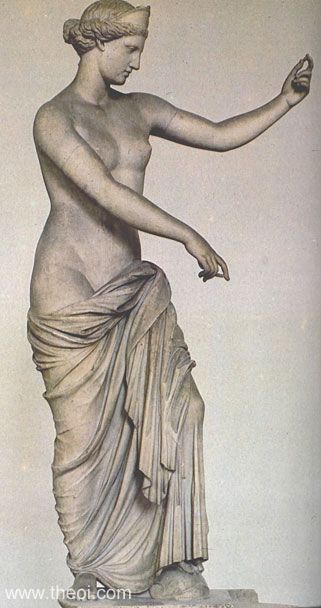
APHRODITE was the Olympian goddess of love, beauty and procreation.
She possessed numerous shrines and temples throughout Greece. This page describes the cult of the goddess in the north-west Peloponnese, central and northern Greece, and the Greek colonies. Her most important cult centre in the Mediterranean was arguably the island of Kypros (Cyprus) where Mysteries were celebrated in her honour. The Cyprian Aphrodite was closely associated with the Phoenician goddess Ashtarte on the Syrian mainland.
Photographs of some of her famous cult statues are presented below including the Venus de Capua and Venus Callipygian "She of the Beautiful Buttocks".
CLASSICAL LITERATURE QUOTES
CULT IN ELIS (SOUTHERN GREECE)
Strabo, Geography 8. 3. 12 (trans. Jones) (Greek geographer C1st B.C. to C1st A.D.)
:
"The whole country [of Elis] is full of temples of Artemis, Aphrodite, and the Nymphai, being situated in
sacred precincts that are generally full of flowers because of the abundance of water."
I. ELIS Main Town of Elis
Cicero, De Natura Deorum 3. 21 - 23 (trans. Rackham) (Roman rhetorician C1st B.C.)
:
"[Cicero presents a number of regional cult genealogies for Aphrodite :] The first Venus [Aphrodite] is the
daughter of Caelus (Sky) and Dies (Day); I have seen her temple at Ellis."
II. TEMNOS Village in Elis
Pausanias, Description of Greece 5. 13. 7 (trans. Jones) (Greek travelogue C2nd A.D.)
:
"If you cross the river Hermos you see an image of Aphrodite in Temnos [in Elis] made of a living
myrtle-tree. It is a tradition among us that it was dedicated by Pelops when he was propitiating the goddess and
asking for Hippodameia to be his bride."
III. OLYMPIA Village & Sanctuary in Elis
Pausanias, Description of Greece 6. 20. 6 :
"Near to the sanctuary of Eileithyia [at Olympia, Elis] are the remains of the sanctuary of Aphrodite
Ourania (Heavenly), and there too they sacrifice upon the altars."
Pausanias, Description of Greece 6. 25. 1 :
"Behind the portico [at Olympia, Elis] built from the spoils of Korkyra is a temple of Aphrodite, the
precinct being in the open, not far from the temple. The goddess in the temple they call Ourania (Heavenly); she
is of ivory and gold, the work of Pheidias, and she stands with one foot upon a tortoise. The precinct of the
other Aphrodite is surrounded by a wall, and within the precinct has been made a basement, upon which sits a
bronze image of Aphrodite upon a bronze he-goat. It is a work of Skopas, and the Aphrodite is named Pandemos
(Common). The meaning of the tortoise and of the he-goat I leave to those who care to guess."
IV. CYLLENE (KYLLENE) Village in Elis
Pausanias, Description of Greece 6. 26. 5 :
"In Kyllene [in Elis] is a sanctuary of Asklepius, and one of Aphrodite."
CULT IN ACHAEA (SOUTHERN GREECE)
I. PATRAE (PATRAI) Main Town of Achaea (Akhaia)
Pausanias, Description of Greece 7. 20. 9 :
"Not far from the theater [of Patrai, Akhaia] is a temple of Nemesis, and another of Aphrodite. The images
are colossal and of white marble."
Pausanias, Description of Greece 7. 21. 10 :
"In Patrai [in Akhaia], not far from that of Poseidon, are sanctuaries of Aphrodite. One of the two images
was drawn up by fishermen in a net a generation before my time. There are also quite near to the harbor two
images of bronze, one of Ares and the other of Poseidon. The image of Aphrodite, whose precinct too is by the
harbor, has its face, hands and feet of stone, while the rest of the figure is made of wood. They have also a
grove by the sea, affording in summer weather very agreeable walks and a pleasant means generally of passing the
time. In this grove are also two temples of divinities, one of Apollon, the other of Aphrodite. The images of
these too are made of stone."
II. AEGIUM (AIGION) Town in Achaea
Pausanias, Description of Greece 7. 24. 2 :
"By the sea at Aigion is a sanctuary of Aphrodite, and after it one of Poseidon."
III. BURA (BOURA) Village in Achaea
Pausanias, Description of Greece 7. 25. 9 :
"There is a temple here [at Boura, Akhaia] of Demeter, one of Aphrodite and Dionysos, and a third of
Eileithyia. The images are of Pentelic marble, and were made by Eukleides of Athens."
IV. AEGEIRA (AIGEIRA) Town in Achaea
Pausanias, Description of Greece 7. 26. 7 :
"They [the people of Aigeira, Akhaia] worship most devoutly [Aphrodite] Ourania (the Heavenly), but human
beings must not enter her sanctuary. But into the sanctuary of the goddess they surname Syria (the Syrian) they
enter on stated days, but they must submit beforehand to certain customary purifications, especially in the
matter of diet."
CULT IN ARCADIA (SOUTHERN GREECE)
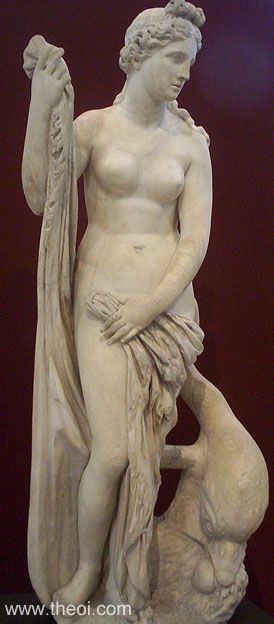
I. MEGALOPOLIS Main City of Arcadia (Arkadia)
Pausanias, Description of Greece 8. 31. 5 - 6 :
"[At Megalopolis, Arkadia] within the enclosure of the Great Goddesses [Demeter and Persephone] is also a
sanctuary of Aphrodite. Before the entrance are old wooden images of Hera, Apollon and the Mousai, brought, it
is said, from Trapezos, and in the temple are images made by Damophon, a wooden Hermes and a wooden Aphrodite
with hands, face and feet of stone. The surname Machanitis (Deviser) given to the goddess is, in my opinion, a
most apt one; for very many are the devices, and most varied are the forms of speech invented by men because of
Aphrodite and her works."
Pausanias, Description of Greece 8. 32. 2 :
"[In the south of Megalopolis, Arkadia :] The sanctuary of Aphrodite too was in ruins, save that there were
left the fore-temple mid three images, one surnamed Ourania (Heavenly), the second Pandemos (Common), and the
third without a surname."
II. MELANGEIA Village in Arcadia
Pausanias, Description of Greece 8. 6. 5 :
"Near the well [outside Melangeia, Arkadia] is a hall of Dionysos and a sanctuary of Aphrodite Melainis.
This surname of the goddess is simply due to the fact that men do not, as the beasts do, have sexual intercourse
always by day, but in most cases by night."
III. MANTINEIA Town in Arcadia
Pausanias, Description of Greece 8. 9. 6 :
"Behind the theater [at Mantineia, Arkadia] I found the remains, with an image, of a temple of Aphrodite
surnamed Symmakhia (Ally). The inscription on the pedestal announced that the image was dedicated by Nikippe,
the daughter of Paseas. This sanctuary was made by the Mantineans to remind posterity of their fighting on the
side of the Romans at the battle of Action."
IV. MT. ANCHISIA (ANKHISIA) Mountain in Arcadia
Pausanias, Description of Greece 8. 12. 9 :
"Near the grave of Ankhises [on Mount Ankhisia near Orkhomenos, Arkadia] are the ruins of a sanctuary of
Aphrodite."
[N.B. This is the Trojan hero Ankhises loved by the goddess Aphrodite.]
V. OCRHOMENUS (ORKHOMENOS) Town in Arcadia
Pausanias, Description of Greece 8. 13. 2 :
"Worth seeing here [at Orkhomenos, Arkadia] is a spring, from which they draw water, and there are
sanctuaries of Poseidon and of Aphrodite, the images being of stone."
VI. PSOPHIS Town in Arcadia
Pausanias, Description of Greece 8. 24. 6 :
"In Psophis [in Arkadia] there is a sanctuary of Aphrodite surnamed Erykine (of Eryx) [a town in Sikelia];
I found only ruins of it remaining, but the people said that it was established by the sons of Psophis. Their
account is probable, for in Sikelia (Sicily) too, in the territory of Eryx, is a sanctuary of [Aphrodite]
Erykine, which from the remotest times has been very holy, and quite as rich as the sanctuary in Paphos."
VII. TEUTHIS Village in Arcadia
Pausanias, Description of Greece 8. 28. 6 :
"There are also at Teuthis [in Arkadia] sanctuaries of Aphrodite and Artemis."
VIII. ACACESIUM (AKAKESION) Village in Arcadia
Pausanias, Description of Greece 8. 37. 12 :
"Here [at the sanctuary of Despoine outside Akakesion, Arkadia] is an altar of Ares, and there are two
images of Aphrodite in a temple, one of white marble, and the other, the older, of wood."
IX. COTILON (KOTILON) Village in Arcadia
Pausanias, Description of Greece 8. 41. 10 :
"In Kotilon [near Mt Kotilos, in Arkadia] is an Aphrodite. She also has a temple, the roof of which is now
gone, and an image of the goddess."
X. TEGEA Town in Arcadia
Pausanias, Description of Greece 8. 48. 1 :
"The market-place [of Tegea, Arkadia] is in shape very like a brick, and in it is a temple of Aphrodite
called ‘in brick,’ with a stone image."
Pausanias, Description of Greece 8. 53. 7 :
"There is also at Tegea a temple . . . of Aphrodite called Paphia (of Paphos). The latter was built by
Laodike, who was descended, as I have already said, from Agapenor, who led the Arkadians to Troy, and it was in
Paphos [in Kypros] that she dwelt."
CULT IN BOEOTIA (CENTRAL GREECE)
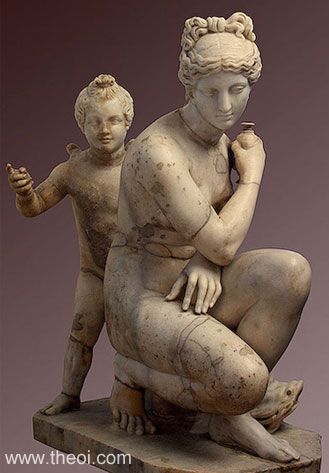
I. THEBES Main City of Boeotia (Boiotia)
Pausanias, Description of Greece 9. 16. 3 :
"At Thebes [in Boiotia] are three wooden images of Aphrodite, so very ancient that they are actually said
to be votive offerings of [the mythical queen] Harmonia, and the story is that they were made out of the wooden
figure-heads on the ships of Kadmos. They call the first Ourania (Heavenly), the second Pandemos (Common), and
the third Apostrophia (Rejecter). Harmoina gave to Aphrodite the surname of Ourania (Heavenly) to signify a love
pure and free from bodily lust; that of Pandemos (Common), to denote sexual intercourse; the third, that of
Apostrophia (Rejecter), that mankind might reject unlawful passion and sinful acts. For Harmonia knew of many
crimes already perpetrated not only among foreigners but even by Greeks, similar to those attributed later by
legend to the mother of Adonis, to Phaidra, the daughter of Minos, and to the Thrakian Tereus."
II. TANAGRA Village in Boeotia
Pausanias, Description of Greece 9. 2. 1 :
"Beside the sanctuary of Dionysos at Tanagra [in Boiotia] are three temples, one of Themis, another of
Aphrodite, and the third of Apollon."
III. THESPIAE (THESPIAI) Village in Boeotia
Pausanias, Description of Greece 9. 27. 5 :
"Here [at Thespiai, Boiotia] too are statues made by Praxiteles himself, one of Aphrodite and one of Phryne
[historic lover of Praxiteles], both Phryne and the goddess being of stone. Elsewhere too is a sanctuary of
Aphrodite Melainis (Black), with a theater and a market-place, well worth seeing."
CULT IN PHOCIS (CENTRAL GREECE)
I. OIANTHEIA Village in Phocis (Phokis)
Pausanias, Description of Greece 10. 38. 9 :
"In Oiantheia [in Phokis] is a sanctuary of Aphrodite."
CULT IN OZOLEAN LOCRIS (CENTRAL GREECE)
I. NAUPACTUS (NAUPAKTOS) Main Town of Locris (Locris)
Pausanias, Description of Greece 10. 38. 12 :
"In a cave [in Naupaktos, Ozolian Lokris] Aphrodite is worshipped, to whom prayers are offered for various
reasons, and especially by widows who ask the goddess to grant them marriage."
CULT IN THESSALY (NORTHERN GREECE)
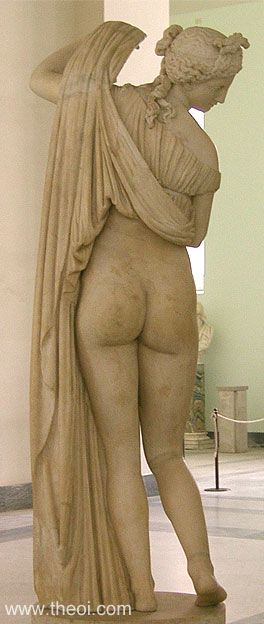
I. METROPOLIS Main City of Histiaiotis in Thessaly (Thessalia)
Strabo, Geography 9. 5. 17 (trans. Jones) (Greek geographer C1st B.C. to C1st A.D.)
:
"Metropolis [in Histiaiotis, Thessalia] in earlier times was a joint settlement composed of three
insignificant towns; but later several others were added to it, among which was Ithome. Now Kallimakhos, in his
Iambics, says that, 'of all the Aphrodites (for there was not merely one goddess of this name), Aphrodite
Kastnietis surpasses all in wisdom, since she alone accepts the sacrifice of swine.' And surely he was very
learned, if any other man was, and all his life, as he himself states, wished to recount these things. But the
writers of later times have discovered that not merely one Aphrodite, but several, have accepted this rite; and
that among these was the Aphrodite at Metropolis, and that one of the cities included in the settlement
transmitted to it the Onthurian rite."
CULT IN THE AEGEAN ISLANDS (GREEK AEGEAN)
Suidas s.v. Enoiketis ton neson (trans. Suda On Line) (Byzantine Greek lexicon C10th
A.D.) :
"Enoiketis ton neson (she who inhabits the islands) : Aphrodite. For she was especially honoured
in them."
Suidas s.v. Zerynthia :
"Zerynthia : [Title of] Aphrodite."
[N.B. Zerynthia was the name of a sacred cave on the island of Samothrake. The goddess of the cave was usually
identified as Hekate.]
CULT IN DELOS (GREEK AEGEAN)
I. DELOS Main Town of Delos
Pausanias, Description of Greece 9. 40. 3 (trans. Jones) (Greek travelogue C2nd A.D.)
:
"At Delos there is a small wooden image of Aphrodite, its right hand defaced by time, and with a square
base instead of feet. I am of opinion that Ariadne got this image from Daidalos, and when she followed Theseus,
took it with her from home. Bereft of Ariadne, say the Delians, Theseus dedicated the wooden image of the
goddess to the Delian Apollon, lest by taking it home he should be dragged into remembering Ariadne, and so find
the grief for his love ever renewed."
CULT IN COS (GREEK AEGEAN)
I. COS (KOS) Main Town of Cos (Kos)
Strabo, Geography 14. 2. 19 (trans. Jones) (Greek geographer C1st B.C. to C1st A.D.)
:
"In the suburb [of the town of Kos on the island of the same name] . . . [a temple of] Aphrodite Anadyomene
(Rising from the Sea) [probably connected with the story of her birth] used to be there, but it is now dedicated
to the deified Caesar in Rome, Augustus thus having dedicated to his father the female founder [Aphrodite] of
his family."
CULT IN ILLYRIA (NORTH OF GREECE)
I. EPIDAMNUS (EPIDAMNOS) Town in Illyria (Greek Colony)
Ptolemy Hephaestion, New History Book 4 (summary from Photius, Myriobiblon 190)
(trans. Pearse) (Greek mythographer C1st to C2nd A.D.) :
"There were many celebrated Helene's . . . the daughter of an inhabitant of Epidamnos, whom the people of
that town honour under the attributes of Aphrodite because she distributed silver during a famine."
CULT IN THRACE (NORTH OF GREECE)
I. ABYDUS (ABYDOS) Town in the Thracian Chersonese (Khersonese)
Musaeus, Hero and Leander 39 ff (trans. Mair) (Greek poetry C5th to 6th A.D.)
:
"Often she [Hero, the priestess of Aphrodite at Abydos] would assuage Eros (Love) too with sacrifices,
together with his Heavenly mother [Aphrodite], fearing his quiver of flame."
CULT IN TEUTHRANIA (ASIA MINOR)
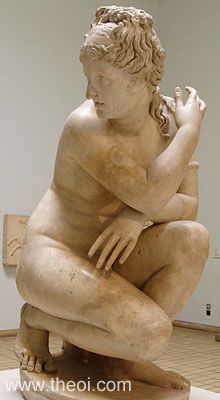
I. Near ANTANDROS Town in Teuthrania
Strabo, Geography 13. 1. 51 (trans. Jones) (Greek geographer C1st B.C. to C1st A.D.)
:
"The Adramyttene Gulf [in Teuthrania] . . . is enclosed by that promontory on which Gargara lies and the
promontory called Pyrrha, on which the Aphrodision (Temple of Aphrodite) is situated . . . Inside is Antandros,
above which lies a mountain called Alexandreia, where the Judgment of Paris is said to have taken place."
CULT IN MYSIA (ASIA MINOR)
I. APATOURON Town in Mysia
Strabo, Geography 11. 2. 10 :
"Sailing into Lake Korokondamitis [near the Bosporos Straits in Mysia] one comes to Phanagoreia ... and to
Apatouron, the sanctuary of Aphrodite . . . Phanagoreion is the metropolis of the Asiatic Bosporians . . . There
is also in Phanagoreia a notable temple of Aphrodite Apatouros (Deceiver). Critics derive the etymology of the
epithet of the goddess by adducing a certain myth, according to which the Gigantes attacked the goddess there;
but she called upon Herakles for help and hid him in a cave, and then, admitting the Gigantes one by one, gave
them over to Herakles to be murdered through ‘treachery’ (apate)."
CULT IN PAMPHYLIA (ASIA MINOR)
I. MT. CASTION (KASTION) Mountain in Pamphylia (near Aspedon)
Callimachus, Iambi Fragment 13 (from Strabo 9. 438) (trans. Trypanis) (Greek poet
C3rd B.C.) :
"Kallimakhos says in his Iambi that of all the Aphroditai--for the goddess is not one goddess only--are
excelled in wisdom by Aphrodite Kastnia (of Mt Kastion in Pamphylia); for she alone rejoices in sacrifice of
swine."
CULT IN CARIA (ASIA MINOR)
I. CNIDUS (KNIDOS) Town in Doris - Caria ( Karia)
Pausanias, Description of Greece 1. 1. 3 (trans. Jones) (Greek travelogue C2nd A.D.)
:
"The Knidians hold Aphrodite in very great honor, and they have sanctuaries of the goddess; the oldest is
to her as Doritis (Bountiful ), the next in age as Akraia (Of the Height), while the newest is to the Aphrodite
called Knidia by men generally, but Euploia (Fair Voyage) by the Knidians themselves."
Philostratus, Life of Apollonius of Tyana 6. 40 (trans. Conybeare) (Greek biography
C1st to C2nd A.D.) :
"There was a man who was in love with a nude statue of Aphrodite which is erected in the island of Knidos;
and he was making offerings to it, and said that he would make yet others with a view to marrying the statue.
But Apollonios, though on other grounds he thought his conduct absurd, yet as the islanders were not adverse to
the idea, but said that the fame of the goddess would be greatly enhanced if she had a lover, determined to pure
the temple of all this nonsense; and when the Knidans asked him if he would reform their system of sacrifice or
their litanies in any way, he replied : ‘I will reform your eyes, but let the ancestral service of your
temple continue as it is.’
Accordingly he called to him the languishing lover and asked him if he believed in the existence of the gods:
and when he replied that he believed in their existence so firmly that he was actually in love with them, and
mentioned a marriage with one of them which he hoped to celebrate shortly, Apollonios replied : ‘The poets
have turned your poor head with their talk of unions of Ankhises and Peleus and other heroes with goddesses; but
I know this much about loving and being loved: gods fall in love with gods, and human beings with human beings,
and animals with animals, and in a word like with like, and they have true issue of their own kind; but when two
being of different kinds contract a union, there is no true marriage or love. And if you only would bear in mind
the fate of Ixion, you would never have dreamed of falling in love with beings so much above you. For he, you
remember is bent and stretched across the heaven like a wheel; and you, unless you get out of this shrine, will
perish wherever you are upon earth, nor will you be able to say that the gods have been unjust in their sentence
upon you.’
Thus he put a stop to this mad freak, and the man went away who said he was in love, after sacrificing in order
to gain forgiveness."
CULT IN LYDIA (ASIA MINOR)
I. SARDIS (SARDEIS) Main City of Lydia
Ptolemy Hephaestion, New History Book 3 (summary from Photius, Myriobiblon 190)
(trans. Pearse) (Greek mythographer C1st to C2nd A.D.) :
"Kroisos [the historical Lydian king], it is said, was conceived during a festival of Aphrodite [in
Sardeis], during which the Lydians have a procession for her decorating the goddess with all their wealth."
CULT IN CYPRUS (EASTERN MEDITERRANEAN)

Herodotus, Histories 1. 199 (trans. Godley) (Greek historian C5th B.C.) :
"The foulest Babylonian custom is that which compels every woman of the land to sit in the temple of
Aphrodite and have intercourse with some stranger once in her life . . . There is a custom like this in some
parts of Kypros."
Herodotus, Histories 1. 105 :
"The city of Askalon in Syria . . . [has a] temple of Aphrodite Ourania [i.e. of the Phoenician goddess
Ashtarte]. This temple, I discover from making inquiry, is the oldest of all the temples of the goddess, for the
temple in Kypros [to Aphrodite] was founded from it, as the Kyprians themselves say; and the temple on Kythera
was founded by Phoinikians from this same land of Syria."
Pausanias, Description of Greece 1. 14. 6 (trans. Jones) (Greek travelogue C2nd A.D.)
:
"Aphrodite Ourania (Heavenly); the first men to establish her cult were the Assyrians, after the Assyrians
the Paphians of Kypros."
THE ADONIA FESTIVAL
Ovid, Metamorphoses 10. 724 ff (trans. Melville) (Roman epic C1st B.C. to C1st A.D.)
:
"[After the death of Adonis, Aphrodite declares she will institute a festival of mourning in Kypros :]
‘Memorials of my sorrow, Adonis, shall endure; each passing year your death repeated in the hearts of men
shall re-enact my grief and my lament [i.e. in the celebration of the festival Adonia].’"
Suidas s.v. Adonia (trans. Suda On Line) (Byzantine Greek lexicon C10th A.D.)
:
"Adonia (Adonis-mourning) : A contraction. We hold the Adonia and we weep for Adonis. [So in] Pherekrates.
They also call the image of Adonis, in this way, an Adonion. Also Adonideios crop, that of Adonis."
Suidas s.v. Adonis :
"Adonis : A proper name. ‘And there was a mourning shrine, such as that on on Libanos for Adonis and
Byblos.’"
Suidas s.v. Adonidos Kepoi :
"Adonidos Kepoi (Gardens of Adonis) : Of lettuce and fennel, which they used to sow in earthenware
pots."
I. PAPHOS Main City of Cyprus (Kypros)
Homeric Hymn 5 to Aphrodite (trans. Evelyn-White) (Greek epic C7th to 4th B.C.)
:
"She [Aphrodite] went to Kypros, to Paphos, where her precinct is and fragrant altar, and passed into her
sweet-smelling temple."
Strabo, Geography 14. 6. 3 (trans. Jones) (Greek geographer C1st B.C. to C1st A.D.)
:
"Palaipaphos [in Kypros], which last is situated at about ten stadia above the sea, has a mooring-place,
and an ancient temple of Aphrodite Paphia. Then [beyond that] to the promontory Zephyria, with a landing-place,
and to another Arsinoe, which likewise has a landing-place and a temple and a sacred precinct. And at a little
distance from the sea is Hierokepis. Then to Paphos, which was founded by Agapenor, and has both a harbor and
well-built temples. It is sixty stadia distant from Palaiphaphos by land; and on this road men together with
women, who also assemble here from the other cities, hold an annual procession to Palaipaphos . . . Then [beyond
that] to a city Soloi, with a harbor and a river and a temple of Aphrodite and Isis."
Pausanias, Description of Greece 8. 5. 2 (trans. Jones) (Greek travelogue C2nd A.D.)
:
"After the capture of Troy the storm that overtook the Greeks on their return home carried Agapenor and the
Arkadian fleet to Kypros, and so Agapenor became the founder of Paphos, and built the sanctuary of Aphrodite at
Palaipaphos (Old Paphos). Up to that time the goddess had been worshipped by the Kyprians in the district called
Golgoi."
Pausanias, Description of Greece 8. 53. 7 :
"There is also at Tegea a temple . . . of Aphrodite called Paphia (of Paphos). The latter was built by
Laodike, who was descended, as I have already said, from Agapenor, who led the Arkadians to Troy, and it was in
Paphos [in Kypros] that she dwelt."
Athenaeus, Deipnosophistae 3. 84c (trans. Gullick) (Greek rhetorician C2nd to 3rd
A.D.) :
"Eriphos in the Meliboia . . . :
A : And here are the pomegranates.
B : How nice they are!
A : Ay, for they say this was the one and only tree that Aphrodite planted in Kypros.
B : Worshipful Berbeia!"
[N.B. Berbeia was a Kyprian cult title of Aphrodite.]
Athenaeus, Deipnosophistae 3. 95f - 96a :
"Antiphanes in The Woman of Korinthos : ‘But you don't know. In Kypros, my master, the
goddess takes such delight in swine that she keeps the beast from feeding on dung, but has forced that job upon
the oxen.’"
Ovid, Metamorphoses 10. 243 ff (trans. Melville) (Roman epic C1st B.C. to C1st A.D.)
:
"Venus' [Aphrodite's] [festival] day came, the holiest festival all Cyprus celebrates; incense rose high
and heifers, with their wide horns gilded, fell beneath the blade that struck their snowy necks."
Ovid, Metamorphoses 10. 560 ff :
"There is a field the people call the close of Tamasenus, the richest part of all the isle of Cypria, which
long ago was hallowed in my [Aphrodite's] name and added as endowment to my shrine. A tree stands in the close
with leaves of gold and golden branches rustling in the breeze [a dedicatory offering, but possibly only
mythical]."
Apuleius, The Golden Ass 11. 218 ff (trans. Walsh) (Roman novel C2nd A.D.) :
"You [Aphrodite] are venerated at the wave-lapped shrine of Paphos."
II. AMATHUS (AMATHOS) Town in Cyprus
Pausanias, Description of Greece 9. 41. 2 (trans. Jones) (Greek travelogue C2nd A.D.)
:
"In Kypros is a city Amathos, in which is an old sanctuary of Adonis and Aphrodite. Here they say is
dedicated a necklace given originally to Harmonia, but called the necklace of Eriphyle, because it was the bribe
she took to betray her husband. It was dedicated at Delphoi by the sons of Phegeus . . . but it was carried off
by the tyrants of Phokis. However, I do not think that it is in the sanctuary of Adonis at Amathos. For the
necklace at Amathus is composed of green stones held together by gold, but the necklace given to Eriphyle was
made entirely of gold, according to Homer."
III. LAPATHUS (LAPATHOS) Town in Cyprus
Strabo, Geography 14. 6. 3 (trans. Jones) (Greek geographer C1st B.C. to C1st A.D.)
:
"The city Lapathos [in Kypros] . . . then one comes to Aphrodision (Sanctuary of Aphrodite), where the
island is narrow, for the passage across to Salamis is only seventy stadia."
IV. MT. OLYMPUS (OLYMPOS) Mountain in Cyprus
Strabo, Geography 14. 6. 3 :
"[Near Karpasia in Kypros is] a promontory and mountain. The mountain peak is called Olympos; and it has a
temple of Aphrodite Akraia (of the Heights), which cannot be entered or seen by women."
V. PEDALION Promontory near Arsinoe in Cyprus
Strabo, Geography 14. 6. 3 :
"A promontory [beyond the city of Arsinoe in Kypros], Pedalion, above which lies a hill that is rugged,
high, trapezium-shaped, and sacred to Aphrodite."
CULT IN EGYPT (NORTH AFRICA)
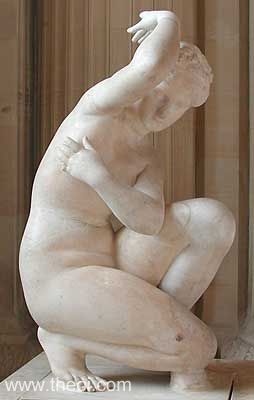
I. ZEPHYRIUM (ZEPHYRION) Cape in Egypt (Aigyptos)
Poseidippus, Epigrams (trans. Page, Vol. Select Papyri III, No. 104b) (Greek elegiac
C3rd B.C.) :
[Epigram composed to celebrate the foundation of a shrine to his wife Arsinoe by Ptolemy II Philadelphos. The
building was a chapel containing an image of Arsinoe, who was worshipped there as Arsinoe-Aphrodite : it stood
on Cape Zephyrion, between Alexandra and Canopus.]
"Midway between the beach of Pharos and the mouth of Kanopos I have my place amid surrounding waters, this
windy breakwater of pastoral Libya, facing the western wind (zephyros) from Italia. Here Kallikrates
established me and called me the Temple of Queen Arsinoe Kypris [i.e. Aphrodite]. Chaste daughters of Hellenes,
hither come to her that shall be named Zephyritis Aphrodite : come, men that labour on the seas. Our Captain
[i.e. Kallikrates] has made this temple a safe harbour from all the waters."
Pseudo-Hyginus, Astronomica 2. 24 (trans. Grant) (Roman mythographer C2nd A.D.)
:
"Conon, the mathematician, and Callimachus call the [constellation the] Lock of Berenice. When Ptolemy had
married his sister Berenice [c. 243 B.C.], daughter of Ptolemy and Arsinoe, and after a few days had set out to
attack Asia, Berenice vowed that if Ptolemy returned as victor she would clip off her hair. She placed the lock,
consecrated by this vow, in the temple of Venus Arsinoe Zephyritis, but on the following day it couldn't be seen
there. When the king was distressed by this, Conon the mathematician, whom we mentioned above, desiring to win
the favor of the king, said that he had seen the lock among the constellations, and pointed out seven stars
without definite configuration which he imagined were the lock."
II. PHAROS Island of Egypt (Greek & Phoenician Colony)
Herodotus, Histories 2. 112 (trans. Godley) (Greek historian C5th B.C.) :
"[On the Egyptian island of Pharos :] There is in the precinct of Proteus a temple called the temple of
Aphrodite Xenia (of the Stranger) [probably founded by the Greek Cyprians, or else a Phoenician temple of
Ashtarte or Egyptian temple of Hathor]; I guess this is a temple of Helene, daughter of Tyndareus, partly
because I have heard the story of Helen's abiding with Proteus, and partly because it bears the name of
Aphrodite Xenia: for no other of Aphrodite's temples is called by that name."
CULT IN LIBYA (NORTH AFRICA)
I. CYRENE (KYRENE) City in Libya (Greek Colony)
Herodotus, Histories 2. 181 (trans. Godley) (Greek historian C5th B.C.) :
"Amasis [Egyptian pharaoh C5th B.C.] made friends and allies of the people of Kyrene. And he decided to
marry from there . . . [so] he married a certain Ladike . . . But whenever Amasis lay with her, he became unable
to have intercourse, though he managed with every other woman . . . So Ladike, when the king did not relent at
all [i.e. in his accusations of witchcraft] although she denied it, vowed in her heart to Aphrodite that, if
Amasis could have intercourse with her that night, since that would remedy the problem, she would send a statue
to Kyrene to her. And after the prayer, immediately, Amasis did have intercourse with her. And whenever Amasis
came to her thereafter, he had intercourse, and he was very fond of her after this.Ladike paid her vow to the
goddess; she had an image made and sent it to Kyrene, where it stood safe until my time, facing outside the
city."
CULT IN SICILY (SOUTHERN ITALY)
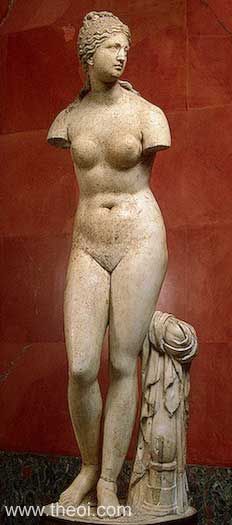
I. ERYX Town in Sicily (Sikelia) (Greek Colony)
Strabo, Geography 6. 2. 6 (trans. Jones) (Greek geographer C1st B.C. to C1st A.D.)
:
"Eryx [in Sikelia (Sicily), Italia], a lofty hill, is also inhabited. It has a temple of Aphrodite that is
held in exceptional honor, and in early times was full of female temple-slaves, who had been dedicated in
fulfillment of vows not only by the people of Sikelia but also by many people from abroad; but at the present
time, just as the settlement itself, so the temple is in want of men, and the multitude of temple-slaves has
disappeared. In Rome, also, there is a reproduction of this goddess, I mean the temple before the Colline Gate
which is called that of Aphrodite [Venus] Erykina and is remarkable for its shrine and surrounding colonnade . .
. Syrakouse and Eryx are each situated like an acropolis by the sea."
Pausanias, Description of Greece 8. 24. 6 (trans. Jones) (Greek travelogue C2nd A.D.)
:
"In Sikelia (Sicily) too, in the territory of Eryx, is a sanctuary of [Aphrodite] Erykine, which from the
remotest times has been very holy, and quite as rich as the sanctuary in Paphos."
Aelian, On Animals 10. 50 (trans. Scholfield) (Greek natural history C2nd to 3rd
A.D.) :
"I have heard it said that in Eryx, where of course the famous temple of Aphrodite is (the pigeons there
and their peculiarities I mentioned earlier on), there is a store of gold, and immense store of silver,
necklaces, and finger-rings of great price; and that dread of the goddess renders them safe from robbers and
untouched; and that men in ancient times always regarded the aforesaid goddess and her treasures with veneration
and awe. But I learn that Hamilkar the Carthaginian looted these objects, melted down the silver and gold, and
then distributed an infamous largesse to his troops. And for these deeds he suffered the most painful and
grievous torments and was punished with crucifixion, while all his accomplices and partners in that unholy
sacrilege died violent and terrible deaths. And his native land which till then was so prosperous and which was
reputed enviable above most lands, after these sacred objects had been imported, was reduced to slavery . .
.
On every day throughout the whole year the people of Eryx and strangers too sacrifice to the goddess. And the
largest of the altars is in the open air, and upon it many sacrifices are offered, and all day long and into the
night the fire is kept burning. The dawn begins to brighten, and still the altar shows no trace of embers, no
ashes, no fragments of half-burnt logs, but is covered with dew and fresh grass which comes up again every
night. And the sacrificial victims from every herd come up and stand beside the altar of their own accord; it is
the goddess in the first place who leads them on, and in the second place it is the ability to pay, and the
wish, on the part of the sacrificer. At any rate should you desire to sacrifice a sheep, lo and behold, there is
a sheep standing at the altar, and you must begin the ceremonial washing. But if you are a man of substance and
wish to sacrifice one cow or even more than one, then the herdsman will not mulct you by charging too much, nor
will you disappoint him, for the goddess sees that the sale-prices are just, and if you pay fairly you will win
her favour. If however you want to buy at a cheaper rate than is proper, you will pay down your money in
vain--the animal departs and you are unable to sacrifice.
So much then for this peculiarity of animals at Eryx in addition to those which I have mentioned earlier
on."
Aelian, Historical Miscellany 1. 15 (trans. Wilson) (Greek rhetorician C2nd to 3rd
A.D.) :
"At Eryx in Sikelia (Sicily), where the holy and venerable temple of Aphrodite stands, the inhabitants of
Eryx at a certain season of the year celebrate with sacrifice the Anagogia (the Embarkation), and they say that
Aphrodite departs from Sikelia for Libya. At that time the pigeons (piresterai) disappear from the
locality as if they were departing with the goddess. For the rest of the year, however, it is a known fact that
a great number of these birds are found at the temple."
CULT OF VENUS IN LATIUM (CENTRAL ITALY)
I. ROME Imperial Capital
Strabo, Geography 6. 2. 6 (trans. Jones) (Greek geographer C1st B.C. to C1st A.D.)
:
"In Rome, also, there is a reproduction of this goddess [Aphrodite of Eryx in Sicily], I mean the temple
before the Colline Gate which is called that of Aphrodite [Venus] Erykina and is remarkable for its shrine and
surrounding colonnade."
Philostratus, Life of Apollonius of Tyana 7. 32 (trans. Conybeare) (Greek biography
C1st to 2nd A.D.) :
"The Emperor [Domitian at Rome] was wearing a wreath of green leaves, for he had just been offering a
sacrifice to Athene in the hall of Adonis [in Rome] and this hall was bright with baskets of flowers, such as
the Syrians at the time of the festival Adonia [in honour of Aphrodite and Adonis] make up in his honour,
growing them under their very roofs."
Suidas s.v. Aphrodite (trans. Suda On Line) (Byzantine Greek lexicon C10th A.D.)
:
"Aphrodite [Venus] : They sculpt the statue of her holding a comb, since a pestilential itch once afflicted
the womenfolk of the Romans, and when they all shaved themselves, their combs became useless to them; they
prayed to Aphrodite to regrow their hair and honoured her with a statue [of her] holding a comb and having a
beard; because she had both male and female parts. For they say she was the overseer of every birth, and they
say she was a man from her loins up and a woman down below. But they also sculpt her on horseback, because
Aeneas, her son, sailed off to the west and after this rode on horseback, and honoured his mother with this sort
of statue."
II. ARDEA Town near Rome in Latium
Strabo, Geography 5. 3. 5 (trans. Jones) (Greek geographer C1st B.C. to C1st A.D.)
:
"Near Ardea [a settlement of the Rutuli in Italia] there is a temple of Aphrodite [i.e. Venus], where the
Latinoi hold religious festivals. But the places were devastated by the Samnitai; and although only traces of
cities are left, those traces have become famous because of the sojourn which Aeneas made there and because of
those sacred rites which, it is said, have been handed down from those times."
CULT IN GAUL (SOUTHERN FRANCE)
I. PYRENEES MTS. Mountains of Gaul
Strabo, Geography 4. 1. 3 :
"Not far from this river [the Varos in Gaul] the seaboard extends as far as the temple of Aphrodite
Pyrenaia (Pyrenean). This temple, moreover, marks the boundary between the province of Narbonitis and the
Iberian country."
[N.B. This is probably the cult of an indigenous goddess rather than the Greek Aphrodite or Roman Venus.]
Strabo, Geography 4. 1. 6 ) :
"The precincts of Aphrodite [lie] on the headland of the Pyrenees [in Gaul]."
SOURCES
GREEK
- The Homeric Hymns - Greek Epic C8th - 4th B.C.
- Herodotus, Histories - Greek History C5th B.C.
- Callimachus, Fragments - Greek Poetry C3rd B.C.
- Greek Papyri III Poseidippus, Fragments - Greek Elegiac C2nd B.C.
- Strabo, Geography - Greek Geography C1st B.C. - C1st A.D.
- Pausanias, Description of Greece - Greek Travelogue C2nd A.D.
- Aelian, On Animals - Greek Natural History C2nd - 3rd A.D.
- Aelian, Historical Miscellany - Greek Rhetoric C2nd - 3rd A.D.
- Athenaeus, Deipnosophistae - Greek Rhetoric C3rd A.D.
- Philostratus, Life of Apollonius of Tyana - Greek Biography C2nd A.D.
- Ptolemy Hephaestion, New History - Greek Mythography C1st - 2nd A.D.
ROMAN
- Hyginus, Astronomica - Latin Mythography C2nd A.D.
- Ovid, Metamorphoses - Latin Epic C1st B.C. - C1st A.D.
- Cicero, De Natura Deorum - Latin Rhetoric C1st B.C.
- Pliny the Elder, Natural History - Latin Encyclopedia C1st A.D.
- Apuleius, The Golden Ass - Latin Novel C2nd A.D.
BYZANTINE
- Photius, Myriobiblon - Byzantine Greek Scholar C9th A.D.
- Suidas, The Suda - Byzantine Greek Lexicon C10th A.D.
BIBLIOGRAPHY
A complete bibliography of the translations quoted on this page.